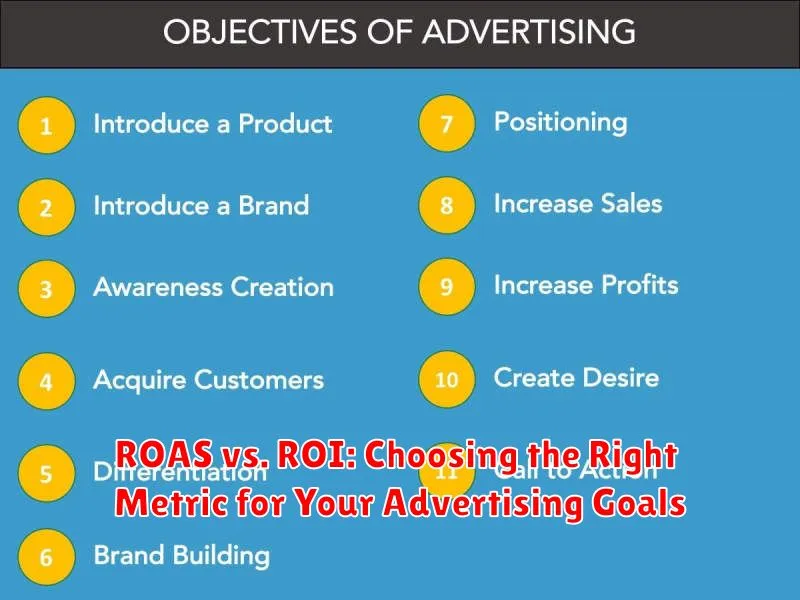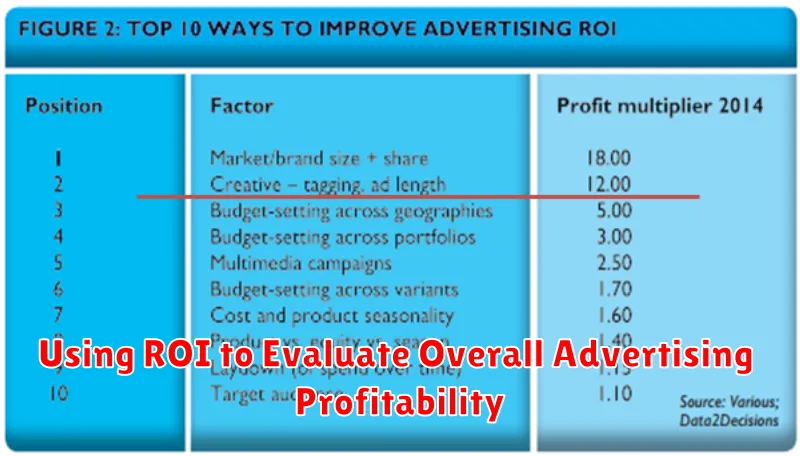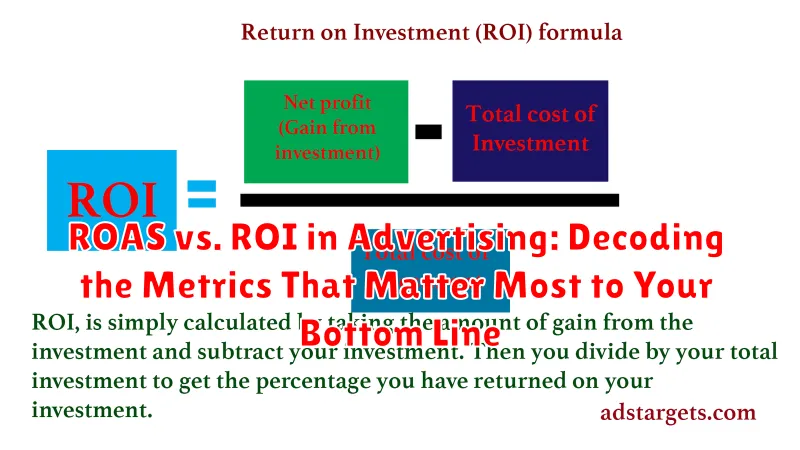In the dynamic world of advertising, understanding the key metrics that drive success is crucial for optimizing campaigns and maximizing profitability. Two of the most commonly discussed and often confused metrics are Return on Ad Spend (ROAS) and Return on Investment (ROI). While both provide insights into the effectiveness of your marketing efforts, they offer distinct perspectives on how your advertising investments translate into actual financial gains. Deciphering the nuances between ROAS and ROI is essential for making informed decisions, allocating resources effectively, and ultimately boosting your bottom line.
This article aims to demystify the concepts of ROAS vs ROI in advertising, providing a comprehensive understanding of their definitions, calculations, and applications. We will explore the strengths and limitations of each metric, highlighting scenarios where one might be more appropriate than the other. Furthermore, we will delve into practical strategies for improving both your ROAS and ROI, empowering you to make data-driven decisions that maximize the financial impact of your advertising campaigns and achieve sustainable growth in your business. By mastering these metrics, you can transform your advertising from a cost center into a powerful engine for revenue generation.
Defining ROAS: A Clear Understanding of Return on Ad Spend
ROAS, or Return on Ad Spend, is a crucial metric in digital advertising that measures the revenue generated for every dollar spent on advertising. Essentially, it quantifies the efficiency of your advertising campaigns by showing how much revenue you are getting back from your ad investments.
ROAS is expressed as a ratio or percentage. A ROAS of 4:1, or 400%, signifies that for every $1 spent on advertising, $4 in revenue is generated. This metric focuses solely on the direct revenue attributable to advertising efforts, excluding other business expenses.
Understanding ROAS is vital for advertisers as it provides a clear picture of which campaigns are performing well and which require optimization or reallocation of resources. It’s a key performance indicator (KPI) for assessing the immediate impact of advertising spend on revenue generation.
Defining ROI: A Comprehensive View of Return on Investment
Return on Investment (ROI) is a performance measure used to evaluate the efficiency of an investment or compare the efficiency of a number of different investments. ROI attempts to directly measure the amount of return on a particular investment, relative to the investment’s cost.
Unlike ROAS, which focuses solely on advertising spend, ROI takes a broader perspective, encompassing all costs associated with a business endeavor. This includes not just advertising costs, but also expenses such as salaries, overhead, production costs, and other operating expenses.
Essentially, ROI provides a more holistic view of profitability by considering all the resources invested to generate a return. A positive ROI indicates that an investment is profitable, while a negative ROI suggests a loss. Analyzing ROI can help in making informed decisions about where to allocate resources and prioritize investments.
The Key Differences Between ROAS and ROI: When to Use Each Metric
While both ROAS (Return on Ad Spend) and ROI (Return on Investment) are crucial metrics for evaluating advertising effectiveness, they differ significantly in scope and application. ROAS focuses specifically on the revenue generated per dollar spent on advertising, providing a granular view of individual campaign performance.
In contrast, ROI offers a broader perspective, encompassing all investment costs, including salaries, overhead, and other related expenses. This holistic approach allows for a comprehensive understanding of the overall profitability of an advertising endeavor.
When to use each metric:
- ROAS: Ideal for optimizing ad campaigns, identifying high-performing channels, and making immediate adjustments to ad spend.
- ROI: Best suited for evaluating the overall success of advertising initiatives, justifying marketing budgets, and making strategic decisions about long-term investments.
Calculating ROAS: A Simple Formula and Practical Examples
ROAS, or Return on Ad Spend, is calculated using a straightforward formula. Understanding this formula is crucial for determining the efficiency of your advertising campaigns.
The ROAS Formula
The formula for calculating ROAS is: ROAS = (Revenue Generated from Ad Campaign / Cost of Ad Campaign) x 100. This results in a percentage or a ratio indicating the return for every dollar spent.
Practical Examples
Let’s consider two examples:
- Example 1: If an ad campaign cost $1,000 and generated $5,000 in revenue, the ROAS would be ($5,000 / $1,000) x 100 = 500%. This means for every $1 spent, the campaign generated $5 in revenue.
- Example 2: If another campaign cost $2,000 and generated $4,000 in revenue, the ROAS would be ($4,000 / $2,000) x 100 = 200%. This indicates a $2 return for every $1 spent.
By applying this simple formula, you can quickly assess the performance of your ad campaigns and make informed decisions about budget allocation.
Calculating ROI: Incorporating All Costs for an Accurate Assessment
Calculating Return on Investment (ROI) demands a thorough approach that considers all associated costs. This is crucial for obtaining an accurate picture of your advertising profitability.
The formula for ROI is: (Net Profit / Total Investment) x 100. It’s important to accurately identify both the net profit and the total investment.
Key considerations for calculating total investment include:
- Advertising Spend: The direct cost of your ad campaigns.
- Production Costs: Expenses related to creating ad content (e.g., design, copywriting).
- Salaries: Costs associated with personnel involved in the advertising process.
- Software & Tools: Expenses for any software or tools used in campaign management and analysis.
- Overhead: A portion of general business expenses allocated to the advertising function.
By incorporating all of these costs, you can achieve a more precise understanding of your advertising campaign’s true ROI.
ROAS vs. ROI: Choosing the Right Metric for Your Advertising Goals

Selecting the appropriate metric between ROAS and ROI is crucial for aligning advertising efforts with broader business objectives. The choice hinges on what you aim to measure and optimize.
If your primary focus is on the efficiency of ad spending and generating revenue directly from campaigns, ROAS is the more suitable metric. It provides immediate feedback on ad performance, allowing for quick adjustments to optimize ad creatives, targeting, and bids.
However, if you’re evaluating the overall profitability of advertising activities and considering all associated costs, including salaries, overhead, and other indirect expenses, ROI provides a more comprehensive picture. ROI is essential for assessing the long-term impact of advertising on the bottom line.
In summary, use ROAS for tactical ad campaign optimization and ROI for strategic assessment of advertising’s contribution to overall business profitability.
Interpreting ROAS and ROI: Understanding What the Numbers Tell You
Interpreting ROAS and ROI requires understanding what each metric signifies in relation to your advertising efforts. A ROAS of 3:1, for instance, suggests that for every dollar spent on advertising, you generate $3 in revenue. ROI, on the other hand, provides a broader perspective, incorporating all investment costs.
Consider the following example:
- ROAS: A ROAS of 5:1 is generally considered good, but the actual benchmark varies by industry.
- ROI: An ROI above 0% indicates profitability, while a negative ROI suggests losses.
Key Considerations:
- Context Matters: Industry benchmarks and business goals should influence interpretation.
- Data Accuracy: Accurate tracking and attribution are crucial for reliable interpretation.
- Continuous Monitoring: Regularly assess ROAS and ROI to identify trends and areas for improvement.
Benchmarking ROAS and ROI: Setting Realistic Performance Targets
Benchmarking is crucial for setting achievable ROAS and ROI targets. It involves researching industry standards, competitor performance, and your own historical data to establish a baseline for comparison. Without benchmarks, you risk setting unrealistic goals that can lead to disappointment and misallocation of resources.
When setting ROAS benchmarks, consider factors such as industry vertical, target audience, and advertising platform. A good ROAS can vary significantly between industries, so it’s essential to research relevant benchmarks for your specific niche. Similarly, for ROI, factor in all associated costs, including operational expenses, salaries, and overhead.
Regularly monitor your ROAS and ROI against your benchmarks and adjust your strategies accordingly. This iterative process allows you to identify areas for improvement and optimize your advertising campaigns for maximum profitability.
Optimizing Campaigns Based on ROAS: Maximizing Ad Spend Efficiency
ROAS (Return on Ad Spend) is a vital metric for understanding the revenue generated for every dollar spent on advertising. Optimizing campaigns based on ROAS involves strategically adjusting elements to improve ad performance and maximize efficiency.
Strategies for ROAS Optimization:
- Keyword Refinement: Identify high-performing keywords and allocate more budget to them. Eliminate underperforming keywords to reduce wasted ad spend.
- Ad Copy Testing: A/B test different ad copies to determine which resonates best with your target audience, improving click-through rates (CTR) and conversion rates.
- Landing Page Optimization: Ensure landing pages are relevant to the ad and offer a seamless user experience to improve conversion rates.
- Audience Targeting: Refine your audience targeting to reach the most relevant users, increasing the likelihood of conversions.
- Bid Management: Adjust bids based on performance data to ensure you’re not overspending on low-performing ads and are maximizing visibility for high-performing ones.
By continuously monitoring and adjusting campaigns based on ROAS, businesses can significantly improve the efficiency of their ad spend and drive higher revenue.
Using ROI to Evaluate Overall Advertising Profitability

Return on Investment (ROI) provides a holistic perspective on the profitability of advertising campaigns by factoring in all associated costs. Unlike ROAS, which focuses solely on ad spend, ROI considers expenses such as salaries, overhead, production costs, and technology investments related to the advertising effort.
A positive ROI indicates that the advertising campaign generated more profit than it cost to execute, while a negative ROI signals a loss. This comprehensive view allows businesses to assess the true impact of advertising on the bottom line, providing valuable insights for strategic decision-making.
Here’s why using ROI is crucial for overall profitability evaluation:
- Comprehensive Cost Analysis: Captures all expenses beyond just ad spend.
- True Profitability Indicator: Reveals the actual return on invested capital.
- Strategic Alignment: Supports informed decisions about resource allocation and campaign adjustments to enhance overall business performance.

